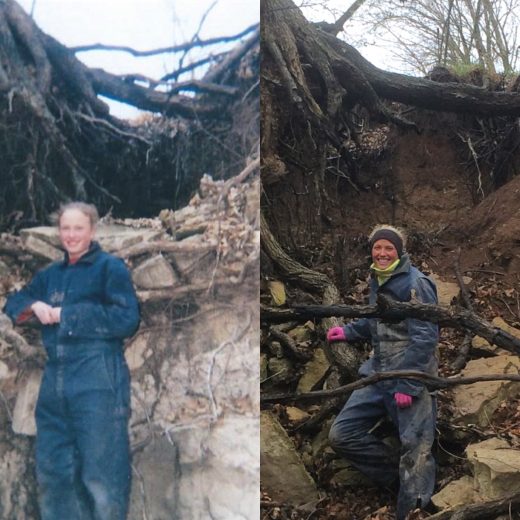Kari Bigham was a typical Kansas farm kid: like any adventurous youngster, she spent her time fishing, fossil hunting, building forts, and exploring the banks of the creek on her parents’ farm just west of Marysville. When she thought about her future, Kari entertained ideas of becoming a park ranger or a meteorologist, but thanks to advice from her father and brother (a K-State civil engineering student at the time), Kari discovered she had an interest and aptitude for engineering.
“As a senior in high school, I didn’t know what an engineer was. Coming from a railroad town, I thought an engineer was just a train conductor,” she said. Later on, she realized that choosing to be a water resources engineer actually combined her two original career paths. Like a meteorologist, her work develops and uses models to make predictions; but, instead of forecasting weather patterns, Kari predicts the environmental processes surrounding streams. Plus, like a park ranger, her work protects and promotes the environment – all while avoiding being “bound to a desk.” According to Kari, her job provides the best of both worlds.
Kari received her bachelor’s and master’s degrees from the Department of Biological and Agricultural Engineering (BAE) at K-State. She is expected to receive her doctoral degree from the same department in December 2020, but her research on streams began well before her work as a Ph.D. student. During her junior year of college, she interned at the University of Idaho where she studied the effects timber harvesting had on stream habitat. The following semester, she enrolled in a fluvial geomorphology (study of rivers) introductory course.

“After that, I was able to take past experiences and observations and begin to understand how agricultural practices in the watershed affected the downstream creek,” she said. She recalled how she would take photos of a gully that had formed on the banks of the creek; the gully caught her eye because it looked like a staircase and had a bunch of fossil-embedded limestone rocks. Now, Kari looks at those old photos and knows exactly how and why that gully formed. She also recalls observing the creek on her family’s property and how, over the course of a decade, it abandoned a stream meander and formed an oxbow lake.
“As a kid, I just liked to visit the new island,” she recalled. “Now, I’m in awe that I got to witness [its formation].”
In addition to her graduate work, Kari is a water resources research technician in K-State’s BAE department as well as a water resources engineering consultant and professional engineer (PE) assisting with streambank stabilization and stream restoration projects. Kari has her PE certification in the State of Kansas and six years of experience in the field of water resources engineering and fluvial geomorphology. Her projects include the woody revetment monitoring in the lower Smoky Hill River watershed and an assessment of John Redmond and Tuttle Creek watershed streambank stabilization sites.
Kari is a member of several professional honor societies and has already earned recognition for her work: she was named the 2017 Young Member of the Year for the Kansas Section of the American Society of Agricultural and Biological Engineers. She plans to finish her degree and wants to either continue her research in the BAE department at K-State or work as a stream restoration and water resources engineering consultant. Kari and her husband, also a graduate of K-State’s BAE program, own a farm east of Topeka, near Grantville.
NICE LETTER some good stuff here
Thanks for reading! We hope you come back each month to learn more about our researchers and their very important work! — KCARE